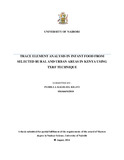| dc.description.abstract | The need for dietary trace elements during periods of rapid growth such as infancy and early childhood is crucial. These elements are required for promotion of good growth, health and behavioural development of an infant. Inadequate dietary intake of these elements may cause delayed sexual maturation, poor growth rate, mediocre work performance, faulty immune functioning, tooth decay and altered hormonal function, ill health and even death. Strategies such as food diversification and modification of indigenous foods have been proposed as a sustainable solution to addressing trace element malnutrition in developing countries. More often, mothers in the developing countries modify the available legume-cereal food to serve as complementary infant foods.
The aim of this study was to determine selected trace elements and some toxic elements that may be present in locally produced complementary infant food from selected rural-urban areas. Ninety samples were collected from Kirwara, Bomet, Mitaboni, Turbo, Sega, Nairobi, Kericho, Kisumu, Eldoret and Thika.
Wet digestion in an open system using nitric acid was used to extract the elements from the sample matrix. This analytical procedure was validated by subjecting certified reference material NIM-GBW10017 to the same analytical procedure. For each digested sample, three aliquots were prepared and analysed using a S2-Picofox TXRF spectrometer.
The levels of Fe, Zn, Cu and Mn varied depending on the origin, type of ingredients used, and probably the proportions of these ingredients in the samples. The levels of these trace elements varied as follows: Mn, 3.31 ± 1.64 mg kg-1 to 329 ± 28 mg kg-1; Fe, 14.6 ± 1.6 mg kg-1 to 376 ± 57 mg kg-1; Cu, 0.72 ± 0.02 mg-1 to 11.0 ± 0.1 mg kg-1; Zn, 11.2 ± 0.2 mg kg-1 to 97.1 ± 4.3 mg kg-1. Concentrations of Pb ranging from 0.12 ± 0.04 mg kg-1 to 0.84 ± 0.16 mg kg-1 were found in approximately 36% of the samples. The concentrations of Fe and Zn were relatively high in cereals-legumes samples compared to samples that were based on cereals only. Finger millet flour had relatively high concentrations of Mn while the maize flour had very low levels of Mn, Fe, Cu and Zn.
v
This study indicates that infants who are fed maize based porridge may tend to be deficient in Zn and Fe as compared to those who are fed equal measures of cereal-legume based porridge. On the other hand, infants who are mainly fed finger millet based porridge may receive higher levels of Mn which may be detrimental to their health. Therefore proper formulation and use of cereallegume based infant porridge flour may alleviate micronutrient malnutrition among infants in developing countries. | en_US |


